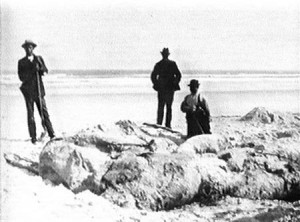(Historic) Gary S. Mangiacopra
From Loren Coleman
Cryptozoologist and Sea Serpent researcher Gary Mangiacopra of Milford, Connecticut, died of a heart attack, age 71, on November 14, 2022.
In 2011, publisher Chad Arment heard from Gary that he had a heart attack and was recovering. In recent months, in an attempt to track down what had become of Gary, the resources of a detective were employed to access official records telling that he had passed away at the end of 2022.
For a half century, Gary Mangiacopra gathered an impressive amount of archives on the question of Sea-Serpents, the American Lake Monsters, and the Giant Octopus of Florida. Gary also worked in other topics of cryptozoology, and mysteries of his home state of Connecticut.
Gary wrote of his early interest in the topics he loved for his Amazon author profile: “I first became interested in the fascinating field of cryptozoology as a young boy after reading magazine articles on the Yeti and Bigfoot. My interest in the field grew throughout adolescence. Later in college, I began conducting formal research in this field, and eventually wrote my Masters Thesis on the “Theoretical Population Estimates of Large Aquatic Animals in Selected Freshwater Lakes of North America.”
He followed the research of Roy Mackal and Bernard Heuvelmans, and wrote “I owe in part some of my success to my good friend and mentor Dr. Arthur E. Gagnon. Over the years his encouragement, coaching, and technical advice, have assisted and helped me to continue my research and writings.”
Gary Mangiacopra, a New Englander with his specific master’s degree in biology, had been interested in doing archival cryptozoological investigations since he was a teen. He became one of the foremost specialists in the study of eighteenth- and nineteenth-century reports of the Sea Serpent in New England.
Gary was a thorough Sea Serpent researcher, and his multi-parted “The Great Unknowns of the 19th Century,” was published in Of Sea and Shore in 1977. In Vol. 8, No. 3 (Autumn 1977), he introduced his systematic classification of his findings. The Mangiacopra system organized sea serpent sightings from New England, a region noted for sightings of coiled sea serpents, many of which were classified as many-humped sea serpents in the Heuvelmans system.
After examining 64 sightings from the 19th Century North Atlantic, Mangiacopra concluded that there were four types of sea serpent represented in these reports. These Mangiacopra types are the dorsal finner, maner, horn head, and many-coiled.
Mangiacopra later determined that many sightings, especially after 1947, did not fit well into any of these categories. According to Mangiacopra, most post-1947 sightings of sea serpents describe animals which resemble his multi-coiled sea monster, but with different body proportions.
Mangiacopra’s five-year study was based on an examination of 64 alleged sea serpent sightings reported in New England (United States) newspapers between 1869 and 1899. Of the 64 cases, he determined that 1 was a hoax, 8 were misidentifications, 7 contained insufficient data to make any conclusions, and 48 were unknown animals or “possible sea serpents.” While he was able to ascertain that the ships and captains mentioned were real, and were in the stated locations, based on the “arriving ships” columns of various newspapers, Mangiacopra admitted that there was no way of knowing how reliable the descriptions themselves were. He based his classifications mainly on secondary features, as the sightings featured few common basic features. Each of the Mangiacopra types was compared to a Heuvelmans type and a LeBlond & Sibert type, the latter system being created for North Pacific reports from the same latitude as New England.
According to Mangiacopra at the time, although the maner and many-coiled were the most commonly reported, sightings of the dorsal finner and horn head contained more details, showing that they were not misinterpretations of the first two types. The distinction between the maner and many-coiled was blurry, but Mangiacopra favored their identification as separate types.
Maniacopra’s details involved:
1) Dorsal Finner
The dorsal finner appeared in five sightings, made between 1878 and 1888. Based on these five sightings, Mangiacopra described it as between 70′ to 100′, with a 9′ to 15′ diameter and a weight of two tons. The skin is smooth, sometimes scaly or warty, and is dull green to dark brown with a lighter yellow underside. The head is compared to that of an alligator or a frog, and is 15′ long, with a 5′ jaw sporting 6” teeth. This type has a single pair of front flippers, a large fin on its back, and vertical undulation allowing it to swim rapidly.
The dorsal finner is somewhat equivalent to the many-humped sea serpent of the Heuvelmans system, and, like the many-humped, the primary theory regarding its identity is a species of cetacean.
The Maner
Based on seven sightings, the maner is a serpentine or eel-like animal, between 15′ and 50′ long, with a flat 3′ head shaped like a horse’s or a snake’s, tapering towards the muzzle. Its eyes are large, and its 10′ neck is slender. Some accounts give it a mane or beard, others quills. Mangiacopra compared the maner to the merhorse of the Heuvelmans system and large eyes of the LeBlond & Sibert system.
In Loren Coleman’s and Patrick Huyghe’s The Field Guide to Lake Monsters, Sea Serpents, and Other Mystery Denizens of the Deep (Tarcher, 2003), describes it as “really just another name for Heuvelmans’ Merhorse.” It may be an unknown species of pinniped.
3) Horn Head
Based on five sightings, the horn head is a long-bodied animal 25′ to 60′ long, with a dark dorsal surface and lighter underside. It has crocodile-like scales, saw-like projections on its back, a forked or pointed tail, and a pair of horns on its flat, round head. The horn head is compared to the long-necked sea serpent of the Heuvelmans system and the small eyes of the LeBlond & Sibert system. Within the Coleman-Huyghe system, the horn head would be part of the Waterhorse type. (Mangiacopra did not speculate on his Horn Head’s possible identity.)
4) Many-Coiled
Based on five sightings, the many-coiled is serpentine, with characteristic curves looping in and out of the surface of the sea, and swims like a snake. Its diameter is small for its length, given as 20′ to 100′, and its seal-like head, which is sometimes described as horned, has a diameter of 2′. The loops are sometimes said to support dorsal fins.
Mangiacopra compared the many-coiled to the super eel of the Heuvelmans system and the serpentine animal of the LeBlond & Sibert system, though it is considered to be more similar to the many-humped sea serpent. Like that type, the many-coiled is speculated to be an archaic, elongated cetacean, possibly similar to Basilosaurus.
5) Eel-Type
A possible fifth type appeared in a single report examined by Mangiacopra, the Rondout serpent of 1886. Mangiacopra compared it to the super-eel due to its long dorsal fin, although the seal-like comparison was reminiscent of the many-coiled.
Lake Monsters too
Gary Mangiacopra also studied American Lake Monsters. He published many articles on various kinds of marine and aquatic cryptids in the journal Of Sea and Shore, and he told, for years, of trying to prepare separate books on Sea Serpents and Lake Monsters.
“In 1980, Gary S. Mangiacopra published the only scientific review of the evidence to date in Of Sea and Shore,” of Sharlie, the Lake Payette Monster, wrote journalist Grove Koger in the Fall 2018 issue of Idaho’s McCall Magazine.
Mangiacopra “concluded that at least some reports might be of pinnipeds—that is, seals. In Mangiacopra’s scenario, Northern Elephant Seals might, just might, have made their way up what were once free-flowing river systems long ago and found themselves trapped in Payette Lake by twentieth century dams.” (Cryptozoologist Roy Mackal would not make this same suggestion until 1996.)
Koger continued: “I have a particular reason for being taken with Gary Mangiacopra’s theory. In 2001 a friend of mine and his brother hiked to Lower Baron Lake in Idaho’s Sawtooth Mountains southeast of Payette Lake. As they approached the shore with their fishing poles, a sealclimbed out of the water onto a rock about thirty feet away and barked at them. The two were so astonished that they withdrew immediately and went fishing elsewhere.Now my friend grew up in the area and has hiked virtually every one of its trails. He’s also seen just about every conceivable animal in the region, including, needless to say, otters. What he and his brother saw that day wasn’t an otter. It was a seal.
“Impossible?
“Yes, of course, but it happened.”
+++
Work through the years: Gary Mangiacopra generously distributed his findings through news items, archival articles, and copies of filmed footages to many people and research groups.
In 1978, Gary attended the FortFest in Washington D.C. to share his findings with others. He did the same at the Lake Champlain Monster Symposium in 1980.
For example, Darren Naish wrote of how Gary shared the Lake Dakataua “Migo” Monster footage of 1994 with others. He was interested in investigating cases collaboratively.
Like several other researchers, I, Loren Coleman, was a frequent correspondent with Gary. His stuffed manila envelopes were filled with clipped articles, handwritten notes, and hard to read carbon copies of letters to others. But Gary rejected any kind of online presence, as well as emails; it became more and more difficult to keep in touch with him.
The last time I was able to have a face-to-face conversation with him was at the International Society of Cryptozoology meeting at Princeton, Rutgers, NJ, 1995.
In 1995, Mangiacopra wrote a major article with Dwight G. Smith, “Connecticut’s Mystery Felines: The Glastonbury Glawackus: 1939-1967” (The Anomalist: 3) on his decades-long investigation of his home state’s Black Panther accounts.
They also collaborated on Dwight G. Smith and Gary Mangiacopra, “What Readers Wrote In: secondary Bigfoot sources as given in the Letters-to-the-Editors column of the 1960s–1970s Men’s Adventure Magazines,” North American BioFortean Review 5:4 issue 13 (December, 2003): 19–31.
In 2007, Gray S. Mangiacopra and Dwight G.Smith published Does Champ Exist? (Coachwhip Publications). It was their first full length book, and was about the possible existence of the Lake Champlain Monsters, Champ, rumored to inhabit Lake Champlain.
Mangiacopra would often tell other researchers that he was currently (in the 1980s-2000s) working on a two-volume book covering Sea Serpents.
On his Amazon profile, he elaborated: “Currently I am working on six books including a two-volume set about sea serpents.”
That dream was never to come true.
Coachwhip publisher Chad Arment writes:
Loren recently noted the passing of long-time Fortean researcher Gary S. Mangiacopra. I had helped Gary with the publication of his Champ conference book (now out of print), but his hoped-for larger book on marine monsters was never completed. Loren reminded me of his various papers in Of Sea and Shore, a conchology publication, and it turns out these are available in an online archive. The archive is a bit unwieldy to search, but there is a PDF download option for each volume. Gary wrote about sea monsters and blobsters of various sorts, back into the 1970s.
Gary Mangiacopra did appear in independent documentaries, as well as on one episode each of Monsterquest (2008) and History’s Mysteries (2009).
Many thanks to various websites who have remembered the work of Gary Mangiacopra, as well as the individuals Roderick Dyke, Hammerson Peters, Chad Arment, Dave Goudsward, Marc Myrsell, and others.

